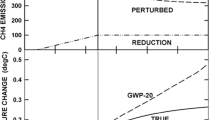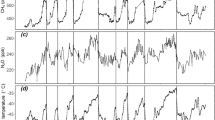Abstract
The concept of global warming potential was developed as a relative measure of the potential effects on climate of a greenhouse gas as compared to CO2. In this paper a series of sensitivity studies examines several uncertainties in determination of Global Warming Potentials (GWPs). For example, the original evaluation of GWPs for the Intergovernmental Panel on Climate Change (IPCC, 1990) did not attempt to account for the possible sinks of carbon dioxide (CO2) that could balance the carbon cycle and produce atmospheric concentrations of CO2 that match observations. In this study, a balanced carbon cycle model is applied in calculation of the radiative forcing from CO2. Use of the balanced model produces up to 21% enhancement of the GWPs for most trace gases compared with the IPCC (1990) values for time horizons up to 100 years, but a decreasing enhancement with longer time horizons. Uncertainty limits of the fertilization feedback parameter contribute a 20% range in GWP values. Another systematic uncertainty in GWPs is the assumption of an equilibrium atmosphere (one in which the concentration of trace gases remains constant) versus a disequilibrium atmosphere (one in which the concentration of trace gases varies with time). The latter gives GWPs that are 19 to 32% greater than the former for a 100 year time horizons, depending upon the carbon dioxide emission scenario chosen. Five scenarios are employed: constant-concentration, constant-emission past 1990 and the three IPCC (1992) emission scenarios. For the analysis of uncertainties in atmospheric lifetime (τ) the GWP changes in direct proportion toτ for short-lived gases, but to a lesser extent for gases withτ greater than the time horizontal for the GWP calculation.
Similar content being viewed by others
References
Bacastow, R. B. and Keeling, C. D.: 1973, ‘Atmospheric Carbon Dioxide and Radiocarbon in the Natural Carbon Cycle: II. Changes from A.D. 1700 to 2070 as Deduced from a Geochemical Model’, inCarbon and Biosphere, Woodwell, G. M. and Pecan, E. V. (eds.), CONF-720510, National Technical Information Service, Springfield, VA, 86–135.
Boden, T. A., Sepanski, R. J., Stoss, F. W.: 1991, ‘Trends 91: A Compendium of Data on Global Change’, CDIAC, Publ. No. ORNL/CDIAC-46, Oak Ridge National Lab, Oak Ridge, U.S.A.
Caldeira, K. and Kasting, F.: 1993, ‘Global Warming on the Margin’,Nature 366, 251–253.
Derwent, R. G.: 1990, ‘Trace Gases and Their Relative Contribution to the Greenhouse Effect’, Harwell Laboratory Report AERE R 13716.
FAO: 1990, ‘Interim Report on Forest Resources Assessment 1990 Project’, Committee on Forestry, Tenth Session, FAO, Rome.
FAO: 1991, ‘Second Interim Report on the State of Tropical Forests’, 10th World Forestry Congress, Paris, France.
Friedli, H., Lîtscher, H., Oeschger, H., Siegenthaler, U., and Stauffer, B.: 1986, ‘Ice Core Record of the13C/12C Ratio of Atmospheric Carbon Dioxide in the Past Two Centuries’,Nature 324, 237–238.
Gammon, R. H., Sundquist, E. T., and Fraser, P. J.: 1985, ‘History of Carbon Dioxide in the Atmosphere’, inAtmospheric Carbon Dioxide and the Global Carbon Cycle, Trabalk, J. R. (ed.), U.S. Dept. of Energy, DOE/ER-0239, Washington, pp. 25–62.
Gargett, A. E., 1976: ‘An Investigation of the occurrence of oceanic turbulence with respect to fine structure’,J. Phys. Oceanogr. 6, 139–156.
Gates, D. M.: 1985, ‘Global Biospheric Response to Increasing Atmospheric Carbon Dioxide Concentration’, in Strain, B. R. and Cure, J. D. (eds.),Direct Effects of Increasing Carbon Dioxide on Vegetation, U.S. Dept. of Energy, DOE/ER-0238, Washington, pp. 171–184.
Goudriaan, J. and Ketner, P.: 1984, ‘A Simulation Study for the Global Carbon Cycle, Including Man's Impact on the Biosphere’,Clim. Change 6, 167–192.
Harvey, L. D. D.: 1993, ‘A Guide to Global Warming Potential’,Energy Policy 21, 24–34.
Harvey, L. D. D.: 1989, ‘Managing Atmospheric CO2’,Clim. Change 15, 343–381.
Harvey, L. D. D. and Schneider, S. H.: 1985, ‘Transient Response to External Forcing on 10 - 10 Year Time Scales, Part I: Experiments with Globally Averaged Coupled Atmosphere and Ocean Energy Balance Models’,J. Geophys. Res. 90, 2191–2205.
Houghton, R. A., Hobbie, J. E., Melillo, J. M., Moore, B., Peterson, B. J., Shaver, G. R., and Woodwell, G. M.: 1983, ‘Changes in Carbon Content of Terrestrial Biota and Soils between 1860–1980: A Net Release of CO2 to the Atmosphere’,Ecol. Mono. 53, 235–262.
Houghton, R. A.: 1991, ‘Tropical Deforestation and Atmospheric Carbon Dioxide’,Clim. Change 19, 99–118.
Intergovernmental Panel on Climate Change, 1990:Climatic Change: The IPCC Scientific Assessment, Houghton, J. T., Jenkins, G. J., and Emphraums, J-J. (eds.), Cambridge University Press, Cambridge, U.K.
Intergovernmental Panel on Climate Change, 1992:Climatic Change 1992, The Supplementary Report to the IPCC Scientific Assessment, Houghton, J. T., Callander, B. A., and Varney, S. K. (eds.), Cambridge University Press, New York.
Jain, A. K. and Bach, W.: 1994, ‘The Effectiveness of Measures to Reduce the Man-Made Greenhouse Effect. The Application of a Climate-Policy Model’,Theor. Appl. Climatol. 49, 103–118.
Jenkins, W. J.: 1980, ‘Tritium and3He in the Sargasso Sea’,J. Mar. Res. 38, 533–569.
Keeling, C. D.: 1973, ‘Industrial Production of Carbon Dioxide from Fuels and Limestone’,Tellus 25, 174–198.
Keeling, C. D., Bacastow, R. B., Carter, A. F., Piper, S. C., Whorf, T. P., Heimann, M., Mook, W. G., and Roeloffzen, H.: 1989, ‘A Three Dimensional Model of Atmospheric CO2 Transport Based on Observed Winds: 1. Analysis of Observational Data’, inAspects of Climate Variability in the Pacific and the Western Americas, Peterson, D. H. (ed.),Geophysical Monograph 55, American Geophysical Union, Washington, pp. 165–236.
Kohlmaier, G. H., Brohl, H., Sire, E. O., Plochal, M., and Revelle, R.: 1987, ‘Modelling Stimulation of Plants and Ecosystem Response to Present Levels of Excess Atmospheric CO2’,Tellus 39B, 155–170.
Kohlmaier, G. H., Revelle, R., Keeling, C. D., and Piper, C. D.: 1991, ‘Reply to Idso’,Tellus 43B, 342–346.
Meyers, N.: 1991, ‘Tropical Forests: Present Status and Future Outlook’,Clim. Change 19, 3–32.
Oeschger, H. and Stauffer, B.: 1986, ‘Review of the History of the CO2 Recorded in Ice Cores’, inThe Changing Carbon Cycle: A Global Analysis, Trabalka, J. R. (ed.), Spring-Verlag, New York, pp. 89–108.
Oeschger, H., Siegenthaler, U., Schotterer, V., and Gugelmann, A.: 1975, ‘A Box Diffusion Model to Study the Carbon Dioxide Exchange in Nature’,Tellus 27, 168–192.
Quay, P. D., Tilbrook, B., and Wong, C. S.: 1992, ‘Oceanic Uptake of Fossil Fuel CO2: Carbon-13 Evidence’,Science 256, 74–79.
Ramanathan, V., Cicerone, R. J., Singh, H. B., and Kiehl, J. T.: 1985, ‘Trace Gas Trends and Their Potential Role in Climate Change’,J. Geophys. Res. 90, 5547–66.
Reilly, J. M. and Richards, K. R.: 1993, ‘Climate Change Damage and the Trace Gas Index Issue’,Env. Res. Econ. 3, 41–61.
Rotty, R. M.: 1987, ‘A Look at 1983 CO2 Emissions from Fossil Fuels (with Preliminary Data for 1984)’,Tellus 39B, 203–208.
Sarmiento, J. L. and Sundquist, E. T.: 1992, ‘Revised Budget for the Oceanic Uptake of Atmospheric Carbon Dioxide’,Nature 356, 589–593.
Sarmiento, J. L., Orr, J. C., and Siegenthaler, U.: 1992, ‘A Perturbation Simulation of CO2 Uptake in an Ocean General Circulation Model’,J. Geophys. Res. 97, 3621–3645.
Siegenthaler, U.: 1983, ‘Uptake of Excess CO2 by an Outcrop-Diffusion Model of the Ocean’,J. Geophys. Res. 88, 3599–3608.
Siegenthaler, U. and Joos, F.: 1992, ‘Use of a Simple Model for Studying Oceanic Tracer Distributions and the Global Carbon Cycle’,Tellus 44B, 186–207.
Siegenthaler, U. and Oeschger, H.: 1987, ‘Biospheric CO2 Emissions during the Past 200 Years Reconstructed by Deconvolution of Ice Core Data’,Tellus 39B, 140–154.
Tans, P. P., Fung, I. Y., and Takahashi, T.: 1990, ‘Observational Constraints on the Global Atmospheric CO2 Budget’,Science 247, 1431–1438.
Wigley, T. M. L.: 1994, ‘The Effect of Carbon Cycle Uncertainties on Global Warming Potentials’,Geophys. Res. Lett. (submitted).
World Meteorological Organization: 1992, ‘Scientific Assessment of Ozone Depletion: 1991’, World Meteorological Organization Global Ozone Research and Monitoring Project - Report No. 25.
Wuebbles, D. J.: 1981, ‘The Relative Efficiency of a Number of Halocarbons for Destroying Stratospheric Ozone’, UCID-18924, Lawrence Livermore National Laboratory, Livermore, CA.
Author information
Authors and Affiliations
Additional information
The U.S. Government right to retain a nonexclusive, royalty-free licence in and to any copyright is acknowledged.
Rights and permissions
About this article
Cite this article
Wuebbles, D.J., Jain, A.K., Patten, K.O. et al. Sensitivity of direct global warming potentials to key uncertainties. Climatic Change 29, 265–297 (1995). https://doi.org/10.1007/BF01091865
Received:
Revised:
Issue Date:
DOI: https://doi.org/10.1007/BF01091865




